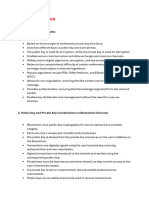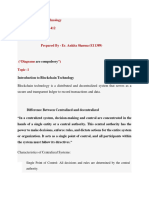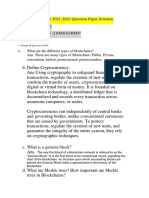0% found this document useful (0 votes)
26 views4 pagesQB
The document outlines the major components of blockchain, including the ledger, smart contracts, peer network, consensus network, membership, events, system management, wallet, and system integration. It also discusses cryptocurrency usage, highlighting the roles of developers, miners, users, merchants, and traders, as well as the differences between hot and cold wallets. Additionally, it explains the UTXO model and the components of a blockchain block, emphasizing their importance for transaction transparency, security, and integrity.
Uploaded by
triveneebadgujar28Copyright
© © All Rights Reserved
We take content rights seriously. If you suspect this is your content, claim it here.
Available Formats
Download as DOCX, PDF, TXT or read online on Scribd
0% found this document useful (0 votes)
26 views4 pagesQB
The document outlines the major components of blockchain, including the ledger, smart contracts, peer network, consensus network, membership, events, system management, wallet, and system integration. It also discusses cryptocurrency usage, highlighting the roles of developers, miners, users, merchants, and traders, as well as the differences between hot and cold wallets. Additionally, it explains the UTXO model and the components of a blockchain block, emphasizing their importance for transaction transparency, security, and integrity.
Uploaded by
triveneebadgujar28Copyright
© © All Rights Reserved
We take content rights seriously. If you suspect this is your content, claim it here.
Available Formats
Download as DOCX, PDF, TXT or read online on Scribd
/ 4



































































































